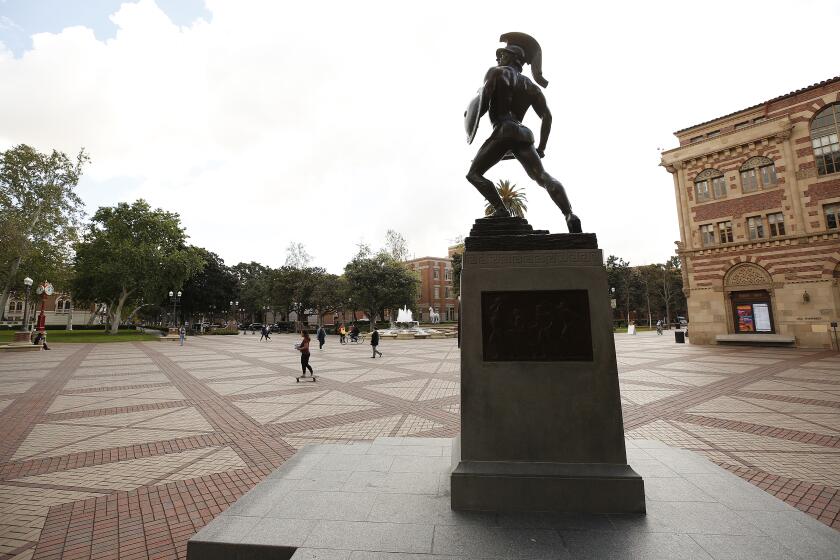Is downtown L.A.’s Figueroa Corridor the next Silicon Valley?
A remarkable transformation is taking place in the heart of Los Angeles. Over the last 10 years, downtown L.A. became vibrant as it built ties to the south, reaching USC and Exposition Park. From the Walt Disney Concert Hall to the California Science Center, a dynamic innovation corridor is taking shape around Figueroa Street.
But the most dramatic change will only come once Figueroa is reinvented to facilitate the flow of people and break down fences. Innovation thrives on clusters: interconnected businesses, creativity across sectors and fluid jobs. Studies have shown how the economic power of business clusters is magnified when activities are linked. Downtown L.A. already has the key nodes: best-in-class businesses, universities and creative venues. All it needs now are the connections.
The time has come for USC and the Expo Park museums to help foster these connections at the street level. The redesign of Figueroa Street, as proposed by the MyFigueroa project, will provide safe and new ways for people to move about the innovation corridor, and spur new destinations for them to meet.
The proposed innovation corridor would tap a rich ecology of experimental media, arts and technology start-ups that already surround the area, with deep ties to the diverse communities of Los Angeles. Consider REDCAT’s interdisciplinary arts center for innovative visual, performing and media arts; the Zemeckis Center for Digital Arts; or Community Services Unlimited’s revolutionary “beyond organic” urban farm in Expo Park.
Innovators would grow their ideas in the brand-new Incubatrix start-up incubator on Hoover Street, LA Makerspace or Nuevo South’s media arts incubator for Latino youth. Mercado La Paloma has become a hub for the area’s entrepreneurs, community activists, artists and musicians. More innovative spaces are in the works, such as the Blackstone LaunchPad announced in February, which will include a new space at USC’s Annenberg School for Communication and Journalism.
To scale and reach global audiences, the corridor needs institutional heft. Not a problem. Already the Figueroa Corridor and the surrounding area is home to world-class arts and culture venues, from the Walt Disney Concert Hall and the California African American Museum to Los Angeles government and civic institutions, including the Central Library. Premier media, entertainment and sports venues line Figueroa, from Staples Center and L.A. Live to the Coliseum and Galen Center. Diverse universities fulfill a variety of research and educational missions, including USC, Mount St. Mary’s College, Loyola Law School, the Fashion Institute of Design & Merchandising and L.A. Trade-Technical College.
This list of entrepreneurial and artistic spaces is growing too quickly to list all of them, and that is precisely the point: the Figueroa Corridor is teeming with community energy, innovative spirit, entrepreneurial drive, artistic vision, civic engagement and technological savvy.
How does it work? A powerful innovation engine requires combining, in a dense urban space, strong cultural, educational, entertainment and government institutions with a deep-rooted network of experimental spaces and pioneering start-ups. Indeed, 21st century innovation will likely rest on a blend for which Los Angeles is remarkably well situated. This includes technology and media but also civic engagement and the arts.
Silicon Valley is built on the physical proximity of firms, suppliers and informal meeting places, whether Denny’s at 3 a.m. or whatever restaurant engineers and venture capitalists favor at any given time. New York City’s Abstract Expressionists thrived while spending their days and nights connecting in studios, clubs and bars along Broadway and Broome and Houston streets. The same potent brew of place-based innovation fuels dynamic urban spaces the world over, from San Francisco’s SoMa District to Tel Aviv’s Rothschild Boulevard to our very own Silicon Beach.
But one critical element is still missing to turn this vision of downtown L.A. into a reality: connections that facilitate the free flow of people and ideas. It is too daunting to walk along or across Figueroa and visit these spaces together. There are too few congenial places along Figueroa for innovators to meet informally, run into one another and have serendipitous conversations that spark new ideas and projects. Innovation is about flow -- about informal encounters rather than formal meetings, when people can connect unexpectedly. Yet today, Figueroa still feels more like a freeway than a boulevard, a place to get through quickly rather than a network of tightly woven institutions that welcome ideas -- and export bold ideas to the world.
If we care about innovation in Los Angeles and believe in the power of clusters, now is the time for MyFigueroa, an ambitious city plan to widen sidewalks, plant street trees and add bike lanes and pedestrian facilities along four miles of Figueroa (more details at myfigueroa.com).
Of course MyFigueroa will make it safer for cyclists and pedestrians, as recently argued in these Opinion pages. More important, however, the proposal is about turning Figueroa into a vital artery along which Los Angeles’ innovative energies can flow freely. MyFigueroa is the critical next step that will usher in the Figueroa innovation corridor.
ALSO:
Feminists hate ‘Princeton mom’s’ advice, but she has science on her side
Francois Bar and John Seely Brown are members of the USC Annenberg Innovation Lab, whose mission embraces media, culture and society as the basis for innovation.
More to Read
A cure for the common opinion
Get thought-provoking perspectives with our weekly newsletter.
You may occasionally receive promotional content from the Los Angeles Times.










